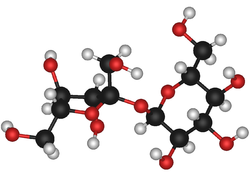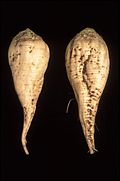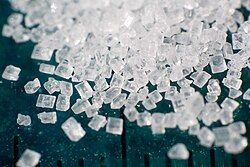Sucrose
| Sucrose | |
|---|---|
| General | |
| Systematic name | Sucrose |
| Other names | Sugar, Saccharose |
| atomic formula | C12H22O11 |
| SMILES | OC1C(OC(CO)C(O)C1O) OC2(CO)OC(CO)C(O)C2O |
| Molar mass | 342.29648 g/mol |
| Appearance | white solid |
| CAS number | [57-50-01] |
| Chemical Properties | |
| Density and phase | 1.587 g/cm³, solid |
| Solubility in water | 211.5 g/100 ml (25°C) |
| Melting point | 186°C (459.15 K) |
| Boiling point | decomposition |
| Chiral rotation [α]D | +66.47° |
| Refractive index | 1.5376 |
| Structure | |
| Molecular shape | ? |
| Crystal structure | monoclinic hemihedral |
| Dipole moment | ? D |
| Hazards | |
| MSDS | External MSDS |
| Main hazards | Combustible |
| NFPA 704 | |
| Flash point | N/A |
| R/S statement | R: ? S: ? |
| RTECS number | WN6500000 |
| Supplementary data page | |
| Structure and properties |
n, εr, etc. |
| Thermodynamic data |
Phase behaviour Solid, liquid, gas |
| Spectral data | UV, IR, NMR, MS |
| Related compounds | |
| Other anions | ? |
| Other cations | ? |
| Except where noted otherwise, data are given for materials in their standard state (at 25°C, 100 kPa) Infobox disclaimer and references | |
| Solubility of Pure Sucrose | |
|---|---|
| Temperature(C) | g sucrose/g water |
| 50 | 2.59 |
| 55 | 2.73 |
| 60 | 2.89 |
| 65 | 3.06 |
| 70 | 3.25 |
| 75 | 3.46 |
| 80 | 3.69 |
| 85 | 3.94 |
| 90 | 4.20 |
Sucrose (common name: table sugar, also called saccharose) is a disaccharide (glucose + fructose) with the molecular formula C12H22O11. Its systematic name is α-D-glucopyranosyl-(1→2)-β-D-fructofuranose. It is best known for its role in human nutrition and is formed by plants but not by higher organisms.
Physical and chemical properties
Pure sucrose is most often prepared as a fine, white, odorless crystalline powder with a pleasing, sweet taste.
Sucrose Media
A table sugar factory in England. The tall diffusers are visible to the middle left where the harvest transforms into a sugar syrup. The boiler and furnace are in the center, where table sugar crystals form. An expressway for transport is visible in the lower left.
References
Yudkin, J.; Edelman, J. and Hough, L. (1973). Sugar - Chemical, Biological and Nutritional Aspects of Sucrose. The Butterworth Group. ISBN 0-408-70172-2.{{cite book}}: CS1 maint: multiple names: authors list (link)
Other websites
- Computational Chemistry Wiki Archived 2006-05-27 at the Wayback Machine
- Nomenclature of Carbohydrates
- 3d Images of Sucrose Archived 2008-12-17 at the Wayback Machine









